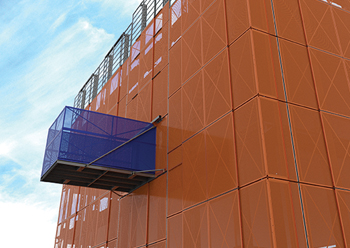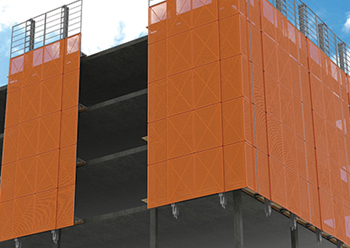Perimeter protection key to site safety
According to a new report by RMD Kwikform (RMDK), formwork plays a key role in helping contractors provide a safe working environment for site operatives on commercial building projects. Here, PAUL WILLIAMS highlights the importance of debris protection solutions.
01 March 2020
In recent years, the number of tall buildings built in the region has soared as countries like the UAE and Saudi Arabia look to forge pathways towards more sustainable growth, foreign investment and tourism.
According to the annual report of the Council on Tall Buildings and Urban Habitat1, as of 2018, there were 1,478 buildings standing at 200 m or higher across the globe. Of these, 143 were completed in 2018 – an increase of 141 per cent over 2010, when there were 614. Shenzhen in China recorded 14 completions in 2018, making it the third year in a row that the city completed the world’s largest number of 200-m-plus buildings, followed closely by Dubai with 10 completions.
Dubai’s skyline has undergone a complete transformation since the 321-m-tall Burj Al Arab tower was completed in 1999, while GCC countries such as Saudi Arabia, Qatar and Kuwait have shown an equally large appetite for building towards the sky since then, such as the 1,008-m Jeddah Tower.
 |
|
Ascent 200 ... designed to accommodate complex building geometries. |
Today, contractors are under incredible pressure to turn developments around quickly, on time and on budget. And, when considering the sheer scale of such projects, tight timeframes and the number of sub-contractors and teams all working under this kind of pressure, it is clear to see how potential safety risks can arise.
In light of this, RMDK undertook research to better understand commercial building construction methods, focusing on safety, productivity and the use of formwork and falsework systems. It surveyed leading contractors and engineering consultants worldwide.
The role that multi-level safety screens below the wet deck play in helping to drive productivity and prevent accidents could be clearly seen in the study. Some 49 per cent of those surveyed agreed that they offer productivity gains, while also improving health and safety; and 35 per cent, the second highest ranked finding, said these systems also help speed up working cycles on facades.
Considering the wider context of increasing urbanisation, fast growth in commercial building projects and this research, debris protection to help ensure the health and safety of workers and the public has never been more important. This is particularly true with cast concrete construction, where slabs extend beyond a building’s footprint, and the opportunity for debris to fall over the edge is high.
Furthermore, particularly in the UAE, buildings are not only getting taller, but more intricate too. The complex geometries of new commercial projects have encouraged more advanced designs and evolved construction techniques, which has enabled buildings to be constructed that would have been simply unimaginable in previous decades. All the while, debris protection to help ensure the health and safety of workers and the public is becoming increasingly important.
REDUCING RISKS
There are plenty of potential risks to consider on commercial building projects. In inner-city areas where there is limited space, pedestrian walkways on the edge of a site need to be protected from falling objects, while on the construction site itself, workers on the ground must be kept safe from building work that is taking place above them.
On the other end of the spectrum, in Abu Dhabi, as in many parts of the world, falls from height – from scaffolding, ladders, ropes, or access platforms – and falling objects are the leading cause of injuries and death on worksites, causing almost 50 per cent of all fatal occupational injuries2.
Debris netting, generally made from heavy-duty plastic, is a typical solution used to protect people from falling objects. For some projects, netting alone will be enough. It provides safe containment of debris, while its versatility means it is easy and economical to handle. It can also hang vertically or horizontally to achieve coverage and allows air movement to help reduce wind loading.
However, workers are exposed to some harsh conditions when operating on a building some 20 storeys up, and protection from the elements can go a long way toward not only a safer job site, but also a more productive one. That is where movable perimeter protection systems come in.
These provide complete protection for workers and the public during the construction of mid- to high-rise buildings. These systems offer protection around the perimeter of the slab, ensuring the safety of the site teams while working at height and making sure that no harmful debris can leave the construction site. This is particularly important for commercial building projects, which often rise up in busy city centres, where even a bolt falling from height can have disastrous consequences.
According to RMDK’s research, when it comes to the issue of debris protection, safety screen systems are the most popular solution, with debris skirts and standard edge protection systems with toe boards considered the next most important preventative measures.
For those seeking an assured debris protection solution, the latest safety screen innovations can help dramatically improve health and safety for workers on site. Ascent 200 – RMDK’S new safety screen system – was developed after extensive market and customer research, and addresses key challenges surrounding health, safety and debris containment.
One of its features is the use of slab jaw brackets that, once opened, allow screens to be removed without having to lift the system up the building. This not only reduces the crane height required but also helps minimise the use of cranes altogether for the job, further increasing site safety.
Ascent 200 also features an advanced hydraulic climbing option, to help further improve operational efficiencies. This feature allows multiple screens to be lifted at the same time from a single hydraulic pump, helping reduce the reliance on crane-assisted lifting.
As part of its research, RMDK also looked into the regulations and attitudes towards the ‘flying’ of equipment on sites, via cranes. What contractors are permitted to do around ‘flying’ equipment is largely dependent on specific site conditions, such as the proximity of neighbouring buildings. While ‘flying’ equipment using cranes is standard practice in the Middle East, measures that can help limit the use of cranes should be encouraged to improve health and safety.
Ascent 200 (www.rmdkwikform.com/ae/products/ascent-200) has also been designed to accommodate complex building geometries, which is why its multiple screen options were developed. Each option offers the highest levels of protection and sealing, while offering customers a choice based on the project specification and shape of the building.
Regardless of what method is used, it is clear that the construction industry in the Middle East has a duty to make the protection of people and health and safety of working sites a priority.
1. Council on Tall Buildings and Urban Habitat, The Skyscraper Center, ‘2018 Year in Review’, https://www.skyscrapercenter.com/year-in-review/2018.
2. The Health Authority – Abu Dhabi (Haad)
https://www.haad.ae/height-aware/.
* Paul Williams is divisional managing director for the Middle East at RMDK, a global temporary works specialist.
- Perimeter protection key to site safety
- L&T wins Etihad Rail freight facilities contract
- News in brief



